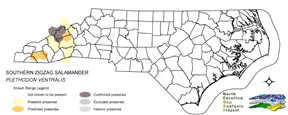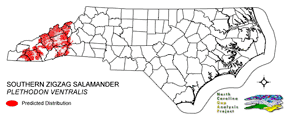
| Taxa: |
| Order: |
| Family: |
| Amphibia |
| Caudata |
| Plethodontidae |
| NatureServe Global Rank: |
| NatureServe State (NC) Rank: |
| G4 |
| S1 |
| Federal Status: |
| NC State Status: |
| --- |
| SC |


| Land Unit |
| US Fish & Wildlife Service |
| US Forest Service |
| US National Park Service |
| US Department of Defense |
| NC State Parks |
| NC University System |
| NC Wildlife Res. Com. |
| NC Forest Service |
| NC Div. of Coastal Mgmt. |
| Local Governments |
| Non-Governmental Org. |
| Other Public Lands |
| Private Lands |
| GAP Status 1-2 |
| All Protected Lands |
| Statewide |
| Hectares |
| 0.00 |
| 154,114.29 |
| 0.00 |
| 27,690.93 |
| 1.44 |
| 0.00 |
| 5,695.02 |
| 1,954.77 |
| 0.00 |
| 6,306.48 |
| 3,031.56 |
| 1.17 |
| 381,753.54 |
| 51,455.04 |
| 198,459.51 |
| 580,549.20 |
| Acres |
| 0.00 |
| 380,824.63 |
| 0.00 |
| 68,425.76 |
| 3.56 |
| 0.00 |
| 14,072.70 |
| 7,387.73 |
| 0.00 |
| 15,583.65 |
| 7,491.15 |
| 2.89 |
| 943,333.36 |
| 129,705.54 |
| 492,961.43 |
| 1,437,125.43 |
| % of Dist. on |
| Prot. Lands |
| 0.0 % |
| 77.7 % |
| 0.0 % |
| 14.0 % |
| < 0.1 % |
| 0.0 % |
| 2.9 % |
| 1.0 % |
| 0.0 % |
| 1.4 % |
| 1.4 % |
| < 0.1 % |
| 0.0 % |
| 25.9 % |
| ----- |
| ----- |
| % of Dist. on |
| All Lands |
| 0.0 % |
| 26.5 % |
| 0.0 % |
| 4.8 % |
| < 0.1 % |
| 0.0 % |
| 1.0 % |
| 0.3 % |
| 0.0 % |
| 1.1 % |
| 0.5 % |
| < 0.1 % |
| 65.8 % |
| 8.9 % |
| ----- |
| ----- |
|
Associated with moist rock formations in mixed hardwood forests (Martof et al. 1980). Common haunts include moist escarpments, rocky ravines and hillsides, incised rivers, talus fields and caves. Populations are often in greatest abundance in and around rocky areas that allow access to deep underground passages and that are in the vicinity of seeps,
springs and streams (Petranka 1998). NATURE SERVE GLOBAL HABITAT COMMENTS: Vicinity of moist rocky crevices in ravines, canyons, rubble, seepages, caves, and wooded slopes. Under rocks, logs, or leaves during day. NATURE SERVE STATE HABITAT COMMENTS: Associated with moist areas of talus slopes or rock outcrops in hardwood forests. |
| Code | Name | Description | NC Natural Heritage Program Equivalent |
| 230 | Piedmont Mesic Forest | American Beech - Red Oak - White Oak Forests. | Mesic Mixed Hardwood |
| 383 | Piedmont Mixed Successional Forest | Generally loblolly mixed with successional hardwoods. Sweetgum, tulip poplar and red maple are common co-dominants in these successional forests. | No equivalent |
| 228 | Piedmont Dry-Mesic Oak and Hardwood Forests | Primarily oak dominated forests, white oak is often dominant, with co-dominants including . Also represented by sweetgum and tulip poplar dominated forests. | Dry Mesic Oak Hickory Forest, Basic Oak Hickory Forest, Dry Oak Hickory Forest |
| 517 | Hemlock Floodplain Forest | Alluvial forest with hemlock and/or white pine in mountains and western piedmont. Hydrology is generally temporarily to seasonally flooded. | Canada Hemlock Forest |
| 522 | Northern Hardwoods | High Elevation forests including yellow birch, American beech, and yellow buckeye. Includes forests with Hemlock and Yellow Birch. | Northern Hardwoods Forest, Boulderfield Forest |
| 525 | Appalachian Oak Forest | A variety of oak forest types including Black, White, Scarlet Oaks in dry to mesic situations. Includes forests historically co-dominated by American Chestnut. | High Elevation Red Oak Forest, Montane White Oak Forest |
| 526 | Appalachian Cove Forest | Mixed Mesophytic forests of the mountains. Includes tuliptree, basswood, yellow buckeye and surgar maple. This class is mapped to include cove forests dominated or co-dominated by hemlock. | Rich Cove Forest, Acidic Cove Forest |
| 527 | Appalachian Hemlock | Upland hemlock forests of the moutains region. Vary from side slopes to steep slope positions. | Canada Hemlock Forest |
|
Thurow, G. R. 1966. Plethodon dorsalis. Cat. Am. Amph. Rep. 29.1-29.3.
Highton, R. 1997. Geographic protein variation and speciation in the PLETHODON DORSALIS complex. Herpetologica 53:345-356. Conant, R. and J. T. Collins. 1991. A field guide to reptiles and amphibians:eastern and central North America. Third edition. Houghton Mifflin Co., Boston, Massachusetts. 450 pp. Redmond, W. H., and A. F. Scott. 1996. Atlas of amphibians in Tennessee. The Center for Field Biology, Austin Peay State University, Miscellaneous Publication Number 12. v + 94 pp. Petranka, J. W. 1998. Salamanders of the United States and Canada. Washington DC: Smithsonian Inst. Press. Mount, R. H. 1975. The Reptiles and Amphibians of Alabama. Auburn University Agricultural Experiment Station, Auburn, Alabama. vii + 347 pp. Martof, B. S., W. M. Palmer, J. R. Bailey, and J. R. Harrison, III. 1980. Amphibians and reptiles of the Carolinas and Virginia. University of North Carolina Press, Chapel Hill, North Carolina. 264 pp. |
For more information please contact them at:
NC-GAP Analysis Project
Dept. of Zoology, NCSU
Campus Box 7617
Raleigh, NC 27695-7617
(919) 513-2853
www.basic.ncsu.edu/ncgap